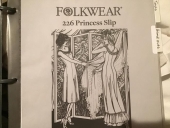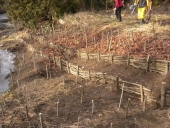

Mk Neal wrote:I think you’ll want to look for materials truly designed to survive outside in soil in all kinds of weather. Something like materials used for pond liners, maybe, or outdoor water tanks.
Many kinds of plastic, for example, get brittle in cold weather and could crack and defeat the purpose. But other kinds that are designed for the purpose and are durable in all weather.

Rebecca Cellabee wrote:
If it's your lower bottom I'd say add triangular godets on the side seams starting about midway up the waist so you get some flare at the hips but in a flattering shape.

Jotham Bessey wrote:I think it's high time people started sewing modern styles. All sewing crafts I see are dresses and night gowns. What about pants and T-shirts?




Peter Ellis wrote:
When thinking about a list of potential coppice trees, I would suggest people begin by looking at their wish list of trees they want for their sites. What trees will do well where you are and fill needs in your system? When you have that list, look through it to learn which ones will coppice well. There's your personal coppice selection ;)
...
Something to keep in mind with coppice systems is that every few years, you're probably going to clear cut a section. Plan around that available space - you're going to have sunlight at ground level for the next two to three years, what crops will you have in that space amongst the coppice stools? Stack functions ;)
...
And let's not forget, many of these trees that will coppice can be started from cuttings - and nursery production is a real economic opportunity. There is no over supply of permaculture nurseries producing permaculture plants as of yet ;)

Eric Hanson wrote:Beau,
Are these American-Chinese hybrid trees? Are they the most recent backcross variant?
The reason I ask is that there are earlier generations of American-Chinese hybrids that are available for considerably less. The problem as I understand is that they are just about guaranteed to eventually succumb to chestnut Blight.
There is a parallel program that specifically inserted one gene into the tree’s genome that produced oxalic acid (if memory is serving me properly here and now). If I am getting this straight, oxalic acid makes the chestnut basically immune to chestnut blight. And also, if I am remembering correctly, oxalic acid is used by all kinds of plants to fight off various fungal pathogens, with wheat being just one example of a harmless (and very useful) plant that uses oxalic acid.
The two programs—backcross and gene insertion—competed for years with the backcross method gaining the early upper hand. Thousands of acres were planted to chestnut trees, infected with blight about 200x stronger than the wild strain, and selected for best resistance. Those seeds (chestnuts) were then pollinated by Chinese chestnut pollen, with the progeny selected for most American traits and best resistance, again infected with 200x blight and those survivors crossed with Chinese and then American and again.
It took a total 6 pairings—three cross pollination and three back crossings to get trees that were 15/16 American, looked 100% American, and only had Chinese blight resistance. This took almost 40 years. The last (6th) generation became available for general purchase just a few years ago and the purchase price reflects this enormous investment.
The parallel program started much, much more recently but ironically ended at about the same time. The parallel program involved splicing in just one gene, something that has been technically doable for decades but only recently has the price come down to consider something outside of a medical concern. The splicing approach is vastly faster, involves only one gene, and requires very little acreage by comparison. I suppose that the parallel approach may be selling their own seeds and they may be able to really get the price down to something much more affordable.
I would be very curious to know exactly what type of chestnut you actually got—a “pre-production” chestnut, a backcross chestnut, or a spliced chestnut.
Eric